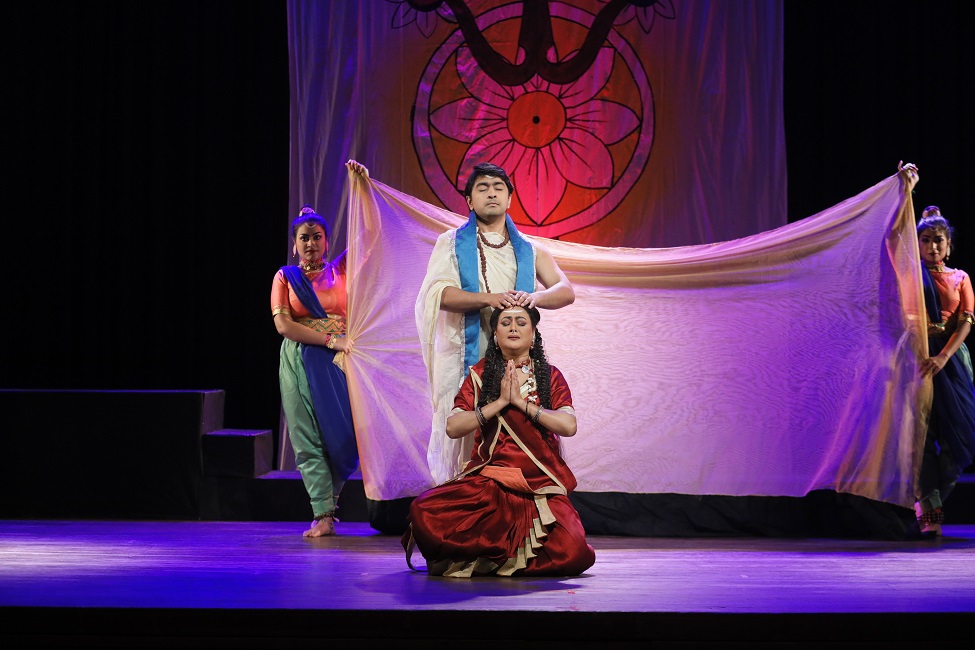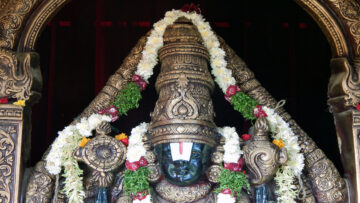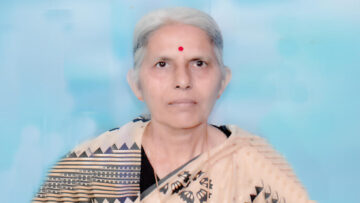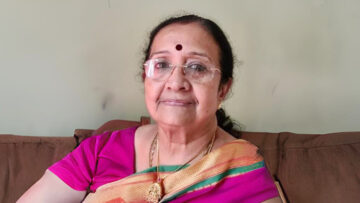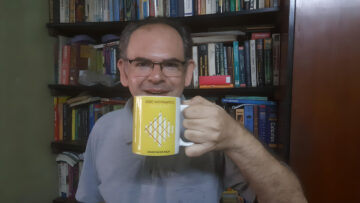Swastik Banerjee is currently pursuing a Doctoral degree in Philosophy at the Department of Philosophy, University of Calcutta. During his Master’s degree in Philosophy at the University of Madras, Swastik Banerjee studied Vedanta under the esteemed guidance of scholars including Mahamahopadhyay Mani Dravid Shastri, Swami Paramananda Bharati, Prof. John Grimes, Prof. Godabarisha Mishra, and others. Swastik Banerjee has also received invaluable guidance and training in the Trika tradition from notable scholars and practitioners such as the late Prof. Debabrata Sen Sharma, Prof. Navjivan Rastogi, Pandit Pran Nath Kaul, Lawrence Small, Giriratna Mishra, and many more. His research focuses on Trika philosophy, popularly known as Kashmir Shaivism, exploring the non-dual nature of reality and the path to self-realization. He is a devoted practitioner of the Kaula Tantric path, having received initiations in both Sri Kula (Mantra Krama) and Kali Kula (Vidya Krama). Demonstrating his creativity, he has written scripts for dance productions, including the notable work “Cidānandavilāsa: recognition of the divinity within,” which received a production grant from the Ministry of Culture, Government of India.
(Figure 1: Still from Cidānandavilāsa, the dance production)
As a scholar who has studied under great teachers, and also immersed yourself in Sanatana traditions, do you think that apart from the external or outer study of our traditions, we need certain tools and quietness in the modern world for awakening and realizing our true nature? How do you personally find the space and time for your practice?
Well, this hinges on one’s perspective of the ātmān, as well as an individual’s inherent nature. I’m not someone who can sit still in silence due to my Attention Deficiency Hyperactivity Disorder. However, even without the ability to remain still and with a mind that frequently jumps from one thought to another, it’s still possible to immerse oneself in that state where ātmān shines. Simply because there is no moment when the ātmān does-not shine.
anastamitabhārūpas tejasāṃ tamasām api |
ya eko ‘ntar yadantaś ca tejāṃsi ca tamāṃsi ca ||
In Tantra, the concept of ātmān is essentially synonymous with Brahman, much like the perception in Vedanta, particularly as found in the Upaniṣads. Therefore, understanding caitanya (consciousness) is a valid approach. When we closely examine our own experiences, including moments of absence of said experiences, we come to realize that caitanya is continuously present. It’s the existence of caitanya that underlies everything.
The need for tools or methods to attain inner stillness arises when direct realization is challenging to achieve. This resonates with the debates among ācāryās who discussed the necessity of understanding what is not Brahman to facilitate self-realization. These tools can be likened to a ladder, which aids in ascending to gain insight and understanding, but once the destination is reached, the ladder loses its significance. The concept of retreating into silence solely for the sake of silence may offer experiences, but not true knowledge. Experiences lack purpose if the ultimate goal remains unknown. Similarly, engaging in rigorous intellectual study without experiential understanding can be fruitless, as one might not fully comprehend the subject of debate. Hence, jñāna (knowledge) and ajñāna (ignorance) have been classified into two categories: one rooted in intellectual understanding and the other tied to the individual soul (jiva). The purification of both aspects is essential in the journey towards realizing the Self.
My encounter with my Trika Guru led me to the profound realization that nothing exists outside of Paramaśiva. These emotions and fluctuations are merely facets of aiśwarya, representing how Śiva perceives Himself within His own mirror of Consciousness. All we need to do is immerse ourselves entirely in this fiery consciousness and embrace our Bhairava nature through the experience. Thus it is stated,
Viśvendhanamahakṣarānulepaśucivarcase |
Mahānalāya bhavate viśvaikahaviṣe namaḥ ||
So how important is it to be an initiate to achieve the utmost goal of Shakti or Devi upasana?
Reiterated in the āgama-s is the principle: ‘karṇāt karṇa upadeśena samprāptam avanītalam / na deyaṃ para śiṣebhyo…’ This underscores that the knowledge within Tantra is inherently esoteric and occult, passed down through whispered teachings from one ear to another, and never to be disclosed to paraśiṣya or ‘outsiders.’ The preservation of secrecy stands as a cornerstone of Tantric traditions. A sincere Tantric practitioner, bound by sacred vows, will steadfastly refrain from revealing ritual secrets or showcasing their knowledge to the public.
However, Tantra should not be regarded as the sole avenue to connect with Devi or attain self-realization, as asserting any one method as the only way would be over simplistic. What primarily remains confidential within Tantra are the specific methodologies and ritual practices. It’s important to recognize that initiation into a particular lineage is not an obligatory requirement. The term Devi is derived from the root ‘div,’ signifying vijigisa, the desire to transcend or surpass, indicating the inherent nature of the Supreme to exist in a state of transcendence. Alternatively, the same root ‘div‘ is also understood as ‘to shine,’ suggesting the concept of Consciousness, which is inherently self-effulgent. Abhinavaguptapādācārya further elaborates on this in his work, Parātrīśikāvivaraṇa. When one comprehends the profound significance of ‘Devi‘ and ‘Śakti,‘ it leads to a deeper understanding of what they are endeavoring to grasp. Since this primordial force is the cause of everything, this is called Ādya Śakti, at this highest state there is no difference between Śiva or Śakti. One may call this by any name they feel like, Mahāviṣṇu, Parābhattārikā, Paramaśiva, Parameśvara, and so on.
The notion of initiation is that of śaktipāt, which can occur through both human and divine channels. Divine initiations are not unheard of, although they are rare. I recall the example of Sadguru Jñānanada Sarasvati, who resided in Chennai. She experienced a state of absolute ecstasy, where Kṛṣṇa appeared as her Guru. Her spiritual stature was also acknowledged by Mahaperiyar of Kanchi. Her Picture is shared below.
(Figure 2 : Sadguru Jñānanada Sarasvati)
(Figure 3 : Sri Swastik with his Guru)
However, in most cases, a human sadguru is deemed necessary for sādhanā, as they provide guidance and support, holding the seeker’s hand and leading them through the steps of their spiritual journey. The purpose of dīkṣā is diyate jñāna sadbhāvaḥ kṣiyate paśuvāsanā. While studying śāstra-s can cleanse the intellect, it is through dīkṣā that the pauruṣājñāna is eradicated. Performing without initiation is like sowing seeds on stone and expecting them to grow,
Adīkṣitā ye kurvanti japaḥ pujādikākriyā|
Na bhavanti priye teṣāṃ śīlāyamupta bijavat||
As you mention , even as there is an explosion of information on Indian Knowledge Systems, and the rituals and mantra practices that accompany them, one still seeks the feet of the Guru. What has been the role of the Guru in your life?
I owe a profound debt of gratitude to my Gurus. My intellectual growth has been shaped by a series of mentors, spanning from my early education through university and beyond. I’ve come to understand that knowledge transcends the confines of formal institutions and degrees; the most impactful teachers are those who possess the wisdom of firsthand experience.
One of my initial influences was my computer teacher in school, who possessed a deep insight into Vedanta. My intellectual clarity gained momentum when I enrolled at Madras University, where I had the privilege of interacting with individuals deeply immersed in the living tradition. It was in the vibrant culture of Southern India that I experienced my initial awakening and encountered my first Guru. From there, I was guided to delve into the study of Trika, a journey that led me to the mystical landscapes of Kashmir and the profound mentorship of the late Prof. Debabrata Sen Sharma, to whom I owe an eternal debt of gratitude.
As my journey continued, I delved deeper into both spiritual practice (sādhanā) and scholarly pursuits. It is often said that, much like bees moving from flower to flower to gather honey, students move from one guru to another in their unceasing quest for knowledge and enlightenment.
I had given two talks on Guru (in Hindi) They can can be viewed here –
गुरु सानिध्य और अनुभूति – Guru Sanidhya aur Anubhuti – Swastik Banerjee
Guru Tattva aur Atma-anubhuti by Swastik Banarjee, at BHU
Many Tantric texts talk about Rājasic and Tāmasic practices but what according to your tradition is the purpose of sadhana. What about the sātvikata of food and speech in cultivating sattva? What about Shraddhā, what does it mean to you?
In Tantric traditions, various forms of practices are prescribed. The concept of Tamasic practices pertains to those that lack self-knowledge and are primarily pursued to attain siddhis, such as control over spirits, without serving a higher purpose. It’s important to acknowledge that while these practices exist within the tradition, they do not necessarily align with the overarching spiritual goals. For instance, the Bhūta Dāmara Tantra directly states that the practices mentioned in that text is not meant for those who walk the path of Brahmajñāna. Rājasic practices represent a more commonplace approach within Tantric traditions. They occupy a middle ground where they may not necessarily lead to a downfall, but they also may not significantly elevate the practitioner. The necessity of sāttvika food plays a crucial role in the initial stages of one’s spiritual journey. However, as a practitioner progresses and attains virabhāva, their ability to perceive divinity in all things diminishes the significance of such distinctions. It’s imperative to understand that one cannot bypass these steps; genuine realization is ultimately achieved through dedicated sādhanā. It’s also worth noting that while adhering to a sāttvika diet, one should not compromise their health and should prioritize consuming nutritious and balanced food.
The primary objective of Tantra sādhanā within my tradition is to attain Kaulikī Siddhi. This represents self-realization, and the method involves the ascent of Kuṇdalini to the Sahasrara. A practitioner is deemed truly liberated when they can move freely up and down without being afflicted at any state of being.
Could you briefly explain about your PhD dissertation on the Problem of the Self in the Anuttara Trika philosophy of Kashmir with special reference to Kṣemarāja and exegetical and critical study.”
My research project is centered around an in-depth exploration and critical analysis of the concept of ‘Self’ or ‘Consciousness’ within the Trika School of Kashmir Śaiva philosophy, with a specific emphasis on the teachings of Kṣemarāja (975-1025 CE), a prominent luminary in the post-Abhinavagupta Trika tradition. Trika, as a philosophical school, asserts that Consciousness is the ultimate reality. This research aims to investigate how this foundational principle is both established and ultimately realized within the Trika tradition. Given the focused nature of this thesis, which primarily involves the examination of the concept ‘Consciousness is Self’ (caitanyamātma), a comprehensive exploration of Kṣemarāja’s broader contributions to Trika philosophy will not be the primary objective. However, it’s important to note that this research is an ongoing process, and at this stage, we can provide only a preliminary overview of our intentions. Much of this is confidential until published.
You have written the script to Cidanandavilāsa: recognition of the divinity within – a dance production. Was it difficult to conceptualize and execute such an abstract topic?
The composition of the Nātya Shastra had a primary objective: to disseminate the sacred wisdom contained within the scriptures to the broader populace. It’s a source of pride for Indians to possess numerous structured doctrines for self-realization. The intention was to provide the audience with a glimpse of this profound knowledge. However, a significant challenge arose in conveying concepts that were unconventional and unfamiliar to the audience. Creating a production that the audience could easily relate to would have been simpler and more conventional, but the creators of Nātya Shastra chose to embark on the less-traveled path to introduce this sacred wisdom to the masses.
(Figure 4 – Another still from the dance production Cidanandavilāasa)
The production depicts the journey of a sādhikā on her path to self-realization. The script sets forth the concept that the world manifests out of ānanda and dissolves back into ānanda. Taking this idea as its foundation, the production then explores the individual’s journey through the world. The seeker is shown moving from one school of philosophy to another, dissatisfied with each one’s approach. Finally, she meets her Guru, who teaches her the highest truth and guides her through a series of experiences. Through these experiences, the seeker finally realizes her true nature. In this process of realization, the production draws on ideas from different spiritual traditions in an attempt to give the audience a taste of the experience of ānanda. This is why the production is called Cidānandavilāsa, which is basically the highest state of experience ‘Jagadānanda’ in Trika.
(Figure 5 : Sādhikā exploring different schools of philosophy)
The solution to this challenge was found by involving my mother in the process, helping her study and grasp the intricate concepts. Pandit Debojyoti Bose played a pivotal role by composing music that corresponded to each stage of the experiential journey. He effectively translated the production from language to music. Subsequently, my mother, Nandita Banerjee, took on the choreography, closely adhering to the principles of Nātya Shastra while incorporating guidance from me. The collaborative efforts of this team culminated in the creation of the production. A glimpse of this remarkable work has been made available online for a wider audience to experience.
Production Trailer can be viewed here :
CIDANANDAVILASA Trailer [ A Trika / Kashmir Shaivism based dance production]
You mention that you are interested in Western esotericism? How would you compare Indian Tantric practices to Western esoteric practices? Is there any common ground?
From my personal viewpoint, I hold the belief that Indian tradition stands as the survivor of the spiritual-cultural legacy from the past. It’s well-documented how ancient polytheistic cultures worldwide faced inquisitions and struggles, being unjustly branded as ‘Satanic,’ ‘evil,’ and subjected to derogatory labels. These traditions, including the Indian heritage, often maintain a profound connection with the natural world. The realm of Western Esotericism is undeniably extensive, encompassing a wide array of practices such as new-age philosophies, Wicca, ceremonial magic, chaos magic, voodoo, and more. My personal engagement with Western Esotericism primarily revolves around the Orphic tradition, centered on the worship of Hecate. Interestingly, a common thread that unites those dedicated to the Goddess, both in the West and in India, is the concept of Bhakti, which is devotion. While it’s not possible to make sweeping generalizations about Western Esotericism, certain textual literatures exist, including divine revelations like the ‘Emerald Tablet.’ Read more about it here: The Emerald Tablet of Hermes Trismegistus | cabinet
Studying Western Esotericism serves to deepen our understanding of our own traditions and practices. Rather than adopting an outsider’s perspective, it’s about recognizing the value of what we have preserved and what we must continue to safeguard. I believe that we have much to offer to the West in the realm of occult knowledge, just as we can benefit from adopting their approach of treating esoteric studies as an academic discipline in the East. This exchange of knowledge and methodologies can enrich both traditions.
I’ve personally harbored a keen interest in this realm from a young age. I believe that there isn’t necessarily a contradiction between different systems if one can gain a clear understanding of each. However, it’s essential to exercise caution when drawing lines and distinctions, as there’s a risk of blending systems and arriving at conclusions that may not accurately represent any of them. Clarity in approach is of paramount importance. In Western traditions, the notions of initiation and gradual evolution on the path, ultimately leading to the identification or union with the Goddess within, bear striking similarities to practices in Tantra. However, it’s equally crucial to be wary of our ideas becoming colonized and losing touch with our foundational roots. Maintaining a strong connection to our traditions is essential in navigating these crossroads of knowledge and spirituality.Let me share a section from the inspirational Wiccan text “Charge of the Goddess” to give an idea,
“Upon earth, She gave the knowledge of the spirit eternal; and beyond death, She gives peace and freedom, and reunion with those who have gone before. Nor does She demand sacrifice, for behold, She is the mother of all living, and Her love is poured out upon the earth. She who is the beauty of the green earth, and the white moon among the stars, and the mystery of the waters, and the desire of the heart of man, calls unto thy soul. Arise, and come unto Her. For She is the soul of nature, who gives life to the universe. from Her all things proceed, and unto Her all things must return; and before Her face, beloved of gods and men, let thine innermost divine self be enfolded in the rapture of the infinite.”
Disclaimer: The opinions expressed in this article belong to the author. Indic Today is neither responsible nor liable for the accuracy, completeness, suitability, or validity of any information in the article.


